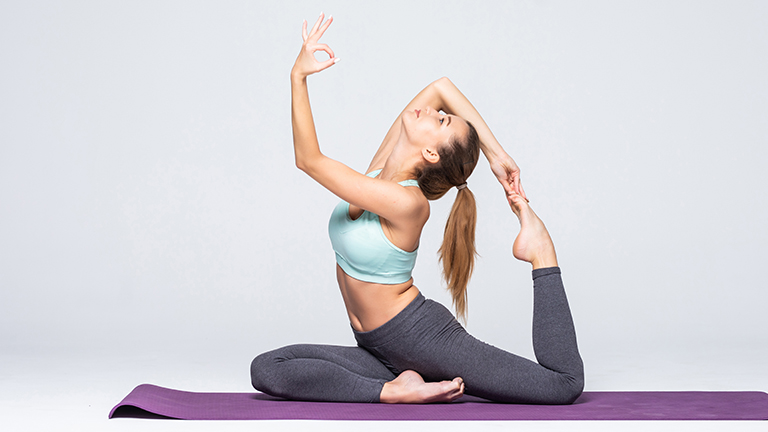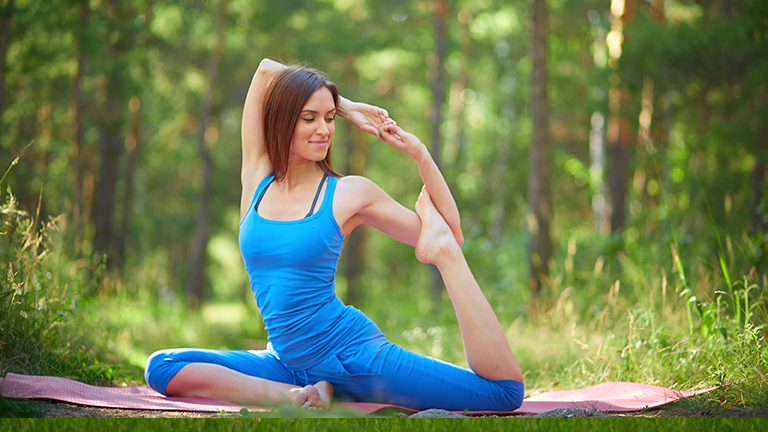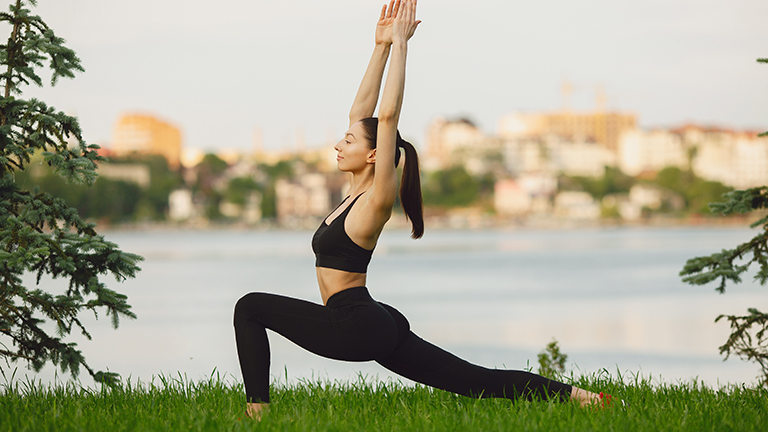In today’s fast-paced world, stress is a pervasive challenge affecting millions. Between career demands, family responsibilities, financial pressures, and the constant digital barrage, modern life often overwhelms our mental and physical resources. While brief episodes of stress can motivate us to act, chronic stress disrupts sleep, weakens immunity, and leads to anxiety, depression, and even physical ailments like hypertension and digestive issues. Yoga for stress has emerged as a scientifically supported method for managing stress naturally. Unlike temporary distractions such as watching TV or scrolling social media, yoga addresses the root causes of stress by calming the nervous system, regulating breathing, and promoting emotional balance. Regular yoga practice teaches the body to shift from a fight-or-flight response to a state of relaxation, restoring both mental clarity and physical well-being.
Scientific research reinforces yoga’s effectiveness for stress relief. Studies show that consistent practice reduces cortisol, lowers blood pressure, improves heart rate variability, and enhances overall mental resilience. Moreover, yoga promotes mindfulness—a key factor in breaking the cycle of stress and anxiety.
In this comprehensive guide, we will explore the mechanisms of stress, yoga poses for relaxation, breathing techniques, meditation practices, daily routines, and lifestyle integration. By the end, you will have a structured road map to using yoga as a holistic stress management tool.
The Connection Between Stress and the Mind-Body System
Stress is not merely a mental phenomenon—it manifests physically, affecting almost every system in the body. When you experience stress, the sympathetic nervous system activates, initiating the fight-or-flight response. This triggers the release of stress hormones such as cortisol and adrenaline, leading to elevated heart rate, shallow breathing, muscle tension, and heightened alertness.
Prolonged activation of this stress response can have serious consequences:
- Cardiovascular strain: Chronic stress raises blood pressure and increases the risk of heart disease.
- Digestive problems: Stress affects gut motility and can lead to bloating, indigestion, or irritable bowel syndrome.
- Sleep disruption: Stress-induced cortisol elevation makes it difficult to fall asleep or stay asleep.
- Weakened immunity: Chronic stress suppresses immune function, making the body more vulnerable to illness.
Yoga helps mitigate these effects by activating the parasympathetic nervous system, often referred to as the “rest-and-digest” mode. This triggers a natural relaxation response, reducing cortisol levels, calming the nervous system, and promoting physiological balance. Through mindful movement, controlled breathing, and meditation, yoga creates a feedback loop in which the body learns to relax, even in stressful situations.
[INSERT_ELEMENTOR id=”5108″]
How Yoga Reduces Stress Naturally
Calming the Nervous System
The nervous system plays a central role in stress, controlling the body’s response to external pressures. When stress triggers the sympathetic nervous system, the fight-or-flight response elevates heart rate, tightens muscles, and releases stress hormones like cortisol. Yoga counters this by activating the parasympathetic nervous system, the body’s natural relaxation mode. Through gentle postures, mindful breathing, and slow movements, yoga signals the nervous system to release tension and restore balance. Techniques such as Child’s Pose, forward bends, and controlled pranayama help lower cortisol, reduce anxiety, and create a sense of calm, making the nervous system more resilient to stress.
Enhancing Emotional Balance
Yoga supports emotional balance by harmonising the mind and body. Through mindful movement, breath work, and meditation, it reduces stress hormones like cortisol while increasing serotonin and endorphins—neurotransmitters linked to happiness and calm. Regular practice helps regulate mood swings, ease anxiety, and improve overall emotional resilience. Postures such as Seated Forward Bend, Legs-Up-The-Wall, and gentle twists encourage release of stored tension, allowing practitioners to process emotions healthily. This combination of physical and mental practice fosters a stable, balanced emotional state.
Building Mindfulness and Awareness
Mindfulness is the practice of observing thoughts, emotions, and sensations without judgement, and yoga is a powerful tool to cultivate it. By combining gentle movements, steady breathing, and focused attention, yoga trains the mind to remain present, reducing rumination and stress. Poses such as Tree Pose or Cat-Cow encourage awareness of posture and breath, while meditation and Yoga Nidra deepen mental focus. Over time, this consistent mindfulness strengthens emotional resilience, helps manage anxiety, and creates a calm, clear, and balanced state of mind, even during daily life’s challenges.
Improving Sleep Quality
Stress often disrupts sleep, making it difficult to fall or stay asleep. Yoga addresses this by calming the nervous system and reducing cortisol levels, preparing the body for restorative rest. Practices like Yoga Nidra, Legs-Up-The-Wall Pose, and gentle forward bends before bedtime help release physical tension and quiet the mind. Controlled breathing techniques, such as Ujjayi or alternate nostril breathing, further promote relaxation. Regular yoga practice improves sleep duration and quality, reduces insomnia symptoms, and supports mental clarity, leaving the body rejuvenated and better equipped to handle daily stress.
Best Yoga Styles for Stress Relief
Restorative Yoga
Restorative yoga is a gentle, slow-paced practice designed to release tension and promote deep relaxation. Using props such as bolsters, blankets, and blocks, the body is fully supported in poses that are held for several minutes, allowing muscles and connective tissues to release stress gradually. This style of yoga directly stimulates the parasympathetic nervous system, lowering heart rate and calming the mind. It is especially effective for individuals experiencing chronic stress, anxiety, or fatigue, as it encourages mindful breathing, emotional release, and a profound sense of inner peace.
Hatha Yoga
Hatha yoga is a foundational style that emphasises gentle postures (asanas) combined with controlled breathing (pranayama) and mindful awareness. Its slower pace makes it ideal for beginners and those seeking stress relief, as it allows the practitioner to focus on alignment, breath, and body sensations. Hatha yoga reduces tension, improves flexibility, and calms the nervous system, helping regulate emotional responses. Regular practice strengthens mind-body connection, enhances mental clarity, and promotes relaxation. By balancing physical movement with mindful attention, Hatha yoga serves as a powerful tool to manage stress and cultivate inner peace.
Yin Yoga
Yin yoga is a slow, meditative style that focuses on holding poses for extended periods, typically three to five minutes. This approach targets deep connective tissues and fascia, releasing long-held tension and stress. By combining stillness with mindful breathing, Yin yoga encourages patience, self-awareness, and emotional release. It also stimulates the parasympathetic nervous system, lowering heart rate and calming the mind. Ideal for stress management, Yin yoga enhances flexibility, promotes mental clarity, and fosters a sense of inner calm, making it an essential practice for anyone seeking long-term relaxation and emotional balance.
Vinyasa Flow Yoga
Vinyasa Flow Yoga is a dynamic style that synchronises movement with breath, creating a flowing sequence of postures. This practice transforms yoga into a moving meditation, helping to release accumulated stress and mental tension. The continuous flow improves circulation, builds strength, and encourages mindfulness by keeping the practitioner fully present in each movement. While more energetic than restorative or Yin yoga, Vinyasa Flow still promotes relaxation by channelling physical energy and calming the mind. It is particularly effective for those who want to combine stress relief with cardiovascular and muscular benefits.
Kundalini Yoga
Kundalini Yoga is a practice that combines physical postures, breathing techniques, chanting, and meditation to balance the body’s energy and promote mental clarity. Known as the “yoga of awareness,” it targets both stress relief and emotional resilience by stimulating the nervous system and releasing stored tension. Breath work and mantra chanting enhance focus, reduce anxiety, and calm the mind, while dynamic movements increase circulation and energy flow. Regular Kundalini practice helps manage stress, improve emotional stability, and cultivate a deeper sense of inner peace and self-awareness, making it a holistic approach to mind-body wellness.
Yoga Poses for Relaxation and Calmness
Simple Yoga Poses for Beginners
Child’s Pose (Balasana)
Child’s Pose gently stretches the hips, thighs, and lower back while calming the nervous system. To practice, kneel on the mat, bring your big toes together, and rest your torso over your thighs. Extend your arms forward or place them alongside your body, letting your forehead touch the mat. Focus on slow, deep breaths, feeling tension melt away with each exhale.
Seated Forward Bend (Paschimottanasana)
Seated Forward Bend stretches the spine, hamstrings, and lower back while promoting mental calmness. Sit with your legs extended, inhale to lengthen your spine, and exhale as you fold forward, reaching for your feet or shins. Keep your breathing steady and allow your body to release tension gradually.
Legs-Up-The-Wall Pose (Viparita Karani)
This pose supports relaxation and circulation. Lie on your back with your legs resting vertically against a wall. Close your eyes and focus on your breath, allowing your body to release stress and rejuvenate.
Advanced Stress-Relieving Postures
Supported Shoulder Stand (Sarvangasana)
Supported Shoulder Stand is an inversion pose that promotes relaxation, improves circulation, and calms the nervous system. Using a folded blanket or bolster under the shoulders provides gentle support, reducing strain on the neck and spine. In this posture, the legs are lifted vertically, and the body weight rests on the shoulders. Practising this pose stimulates blood flow to the brain, reduces fatigue, and balances hormonal function, contributing to emotional stability. Focusing on slow, controlled breathing while holding the pose enhances mindfulness and helps release accumulated stress from both body and mind.
Reclined Bound Angle Pose (Supta Baddha Konasana)
Reclined Bound Angle Pose is a restorative posture that opens the hips, stretches the inner thighs, and promotes deep relaxation. Lie on your back with the soles of your feet together and knees gently falling outward. Support your knees with blocks or blankets if needed. This posture encourages the release of stored tension in the lower body and activates the parasympathetic nervous system, helping to calm the mind. Practising mindful breathing while in this pose enhances emotional release, reduces anxiety, and fosters a profound sense of inner peace and mental clarity.
Corpse Pose (Savasana)
Corpse Pose, or Savasana, is the ultimate relaxation posture, often practised at the end of a yoga session to integrate the benefits of the practice. Lie flat on your back with arms relaxed at your sides and palms facing upward. Close your eyes and focus on slow, steady breathing, allowing the body to release tension completely. This pose calms the nervous system, reduces stress hormone levels, and promotes mental clarity. Practising Savasana regularly enhances emotional balance, supports restorative sleep, and provides a profound sense of inner peace and rejuvenation.
The Role of Breathing Exercises in Stress Management
Pranayama for Stress Control
Pranayama, the yogic practice of breath control, is a powerful tool for managing stress and calming the mind. Conscious breathing directly influences the nervous system, signalling the body to shift from the fight-or-flight response to the parasympathetic “rest-and-digest” mode. Techniques such as Nadi Shodhana (alternate nostril breathing), Bhramari (bee breath), and Ujjayi (ocean breath) help regulate oxygen flow, reduce anxiety, and promote mental clarity. Practising pranayama daily improves emotional resilience, balances energy, and enhances focus, making it an essential component of yoga for stress relief and overall mental well-being.
Nadi Shodhana (Alternate Nostril Breathing)
Nadi Shodhana, or Alternate Nostril Breathing, is a pranayama technique that balances the left and right hemispheres of the brain, promoting mental clarity and calmness. Sit comfortably with a straight spine, close your right nostril with your thumb, inhale through the left nostril, then close the left nostril with your ring finger and exhale through the right. Alternate sides for several minutes while maintaining slow, deep breaths. This practice reduces anxiety, lowers heart rate, and stimulates the parasympathetic nervous system, helping to release stress and enhance focus, making it ideal for both beginners and advanced practitioners.
Bhramari (Bee Breath)
Bhramari, or Bee Breath, is a calming pranayama technique that soothes the nervous system and reduces mental tension. To practice, sit comfortably with a straight spine, close your eyes, and inhale deeply through your nose. As you exhale, produce a steady humming sound like a bee, feeling vibrations resonate in the head and chest. This practice lowers stress hormone levels, eases anxiety, and enhances focus and emotional balance. Bhramari is particularly effective for calming the mind after a busy day, improving concentration, and fostering a deep sense of relaxation and inner peace.
Ujjayi Breath (Ocean Breath)
Ujjayi Breath, also known as Ocean Breath, is a pranayama technique that promotes relaxation and mental focus. Sit comfortably or practice during asanas, slightly constricting the throat while inhaling and exhaling through the nose to create a soft, ocean-like sound. This controlled breath increases oxygen flow, soothes the nervous system, and enhances concentration. Practising Ujjayi Breath helps reduce anxiety, stabilise emotions, and deepen mindfulness during yoga sessions. It is especially effective when combined with Vinyasa Flow or restorative poses, transforming the practice into a moving or still meditation that calms both body and mind.
Meditation and Mindfulness in Yoga Practice
Meditation enhances the stress-reducing effects of yoga by training the mind to remain present. Mindfulness meditation prevents overthinking, reduces anxiety, and cultivates emotional resilience.
Guided meditation, mantra repetition, and Yoga Nidra (yogic sleep) are especially effective. For instance, Yoga Nidra guides you into a deeply relaxed state while maintaining full awareness, helping release accumulated stress. Regular meditation also strengthens neuroplasticity, improving cognitive function and emotional regulation.
Daily Yoga Routine for Stress Reduction
Consistency is crucial for long-term stress management. Even a short 20–30 minute session can create meaningful results when practices daily.
- Morning Routine: Energise your body with gentle stretches, Sun Salutations, and mindful breathing.
- Evening Routine: Release the day’s tension with restorative poses, deep breathing, and meditation.
- Weekend Deep Relaxation: Dedicate 45–60 minutes to restorative or Yin yoga for profound mental and physical rejuvenation.
Over time, daily yoga becomes a coping mechanism, reducing stress reactivity and improving resilience to everyday challenges.
Benefits of Practising Yoga for Stress Relief
The benefits of yoga extend beyond immediate stress relief. Practitioners often experience:
- Enhanced focus and clarity
- Emotional stability and patience
- Better sleep and energy levels
- Improved immunity
- Greater mind-body awareness
- Overall holistic well-being
Scientific Studies on Yoga and Stress Management
Multiple studies confirm yoga’s effectiveness for stress reduction. For example:
- A Journal of Alternative and Complementary Medicine study reported significant reductions in cortisol levels after an eight-week yoga intervention.
- Another clinical trial found that yoga improved sleep quality and reduced anxiety symptoms in adults with generalised anxiety disorder.
These findings demonstrate that yoga’s combination of movement, breath work, and mindfulness has measurable effects on mental health and stress management.
Tips for Beginners Starting Yoga for Stress Relief
Beginners should focus on:
- Establishing a consistent routine
- Prioritising gentle poses and controlled breathing
- Using props for comfort and support
- Following guided classes or tutorials
- Practising mindfulness alongside physical movements
Gradual progression helps avoid frustration, enhances motivation, and ensures sustainable stress relief.
Common Mistakes to Avoid When Using Yoga for Stress
Avoid these mistakes to maximise benefits:
- Practising irregularly
- Comparing progress with others
- Ignoring breathing techniques
- Rushing through poses
- Using yoga as a superficial exercise without mindful attention
Focusing on quality over quantity ensures optimal results.
Combining Yoga with Lifestyle Changes for Stress-Free Living
Yoga works best when integrated with healthy habits:
- Balanced diet and hydration
- Limiting caffeine and sugar
- Digital detox and screen breaks
- Journaling and gratitude practice
- Nature walks and mindful living
This holistic approach enhances yoga’s effects, creating sustainable stress management.
Expert Opinions on Yoga for Stress Management
Experts across psychology, medicine, and yoga consistently recognise yoga as an effective tool for stress management. The American Psychological Association highlights yoga’s ability to regulate the nervous system and enhance emotional resilience. Psychologists and researchers note that combining postures, controlled breathing, and mindfulness improves mental clarity, reduces anxiety, and lowers cortisol levels. Yoga instructors emphasise that even short daily sessions can produce measurable benefits, fostering relaxation and emotional balance. Experts agree that integrating yoga into a consistent routine promotes long-term stress reduction, improved sleep, and overall mental and physical well-being.
Final Thoughts: Embracing Yoga for a Balanced Life
Stress is an inevitable part of modern life, but suffering from it is not. Yoga for stress offers a holistic, natural, and scientifically supported path to balance the mind, body, and spirit. By combining physical postures, breathing exercises, and meditation, yoga retrains the nervous system to respond calmly rather than reactively. Regular practice helps reduce cortisol levels, release muscle tension, improve sleep quality, and enhance emotional resilience. Integrating yoga into daily routines—whether through morning energising sessions, evening restorative practices, or weekend deep relaxation—creates sustainable stress relief and promotes overall well-being. Beyond the physical benefits, yoga cultivates mindfulness, self-awareness, and emotional balance, equipping practitioners to navigate life’s challenges with clarity and patience. Embracing yoga as a lifestyle, rather than a temporary activity, allows individuals to experience lasting calm, inner peace, and a profound sense of harmony in all aspects of life.



